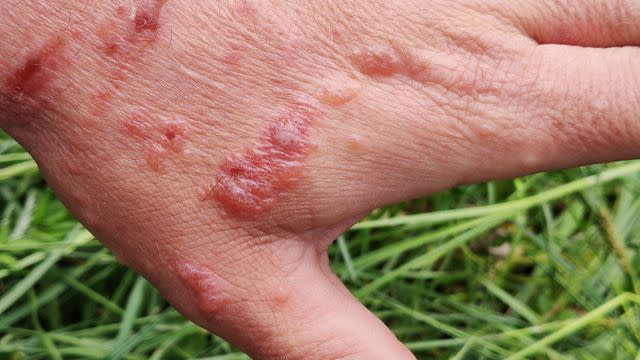Giant Hogweed Burns: How to Avoid the Plant and Treat the Reaction
Medically reviewed by Susan Bard, MD
Giant hogweed (Heracleum mantegazzianum) also known as giant cow parsley, hogsbane, or cartwheel-flower, is a plant in the carrot family. People who touch its sap may develop giant hogweed burns, which can cause skin-related symptoms like inflammation and severe redness.
Giant hogweed now grows in some regions of Britain, other parts of Western Europe, and Canada. In the United States, the plant can be found in Maine, Wisconsin, New York, New Jersey, Virginia, Oregon, and Washington. According to the U.S. Department of Agriculture (USDA), giant hogweed is an invasive, noxious weed.
This article will review everything you need to know about giant hogweed burns, including symptoms, prevention tips, and treatment options.

DERO2084 / Getty Images
What Does Giant Hogweed Look Like?
Giant hogweed was initially grown as an ornamental plant for gardeners due to its attractive, lacelike appearance. Typically around 10 feet tall, the plant has serrated, lobed leaves and long, thick, hairy stems that are spotted with reddish-purple patches.
Giant hogweed usually flowers in mid-June. Its white flowers grow at the top of each stem in large, flat clusters known as umbels.
Understanding Giant Hogweed Burns
Giant hogweed causes burns on the skin due to the effects of chemical compounds known as furanocoumarins. If someone comes into direct contact with these compounds through the plant’s sap, they may experience phototoxicity.
Phototoxicity is a condition that causes the skin and/or eyes to become highly photosensitive, meaning sensitive to light.
This can lead to phytophotodermatitis, a skin reaction that mimics extreme sunburn. Symptoms may be severe, including inflammation, redness, blisters, peeling, and permanent scarring. In rare cases, skin grafts may be necessary. If giant hogweed sap gets into your eyes, you may experience vision problems and even blindness.
Symptoms of Giant Hogweed Burns
Skin-related symptoms of giant hogweed burns may include:
Rash, including redness and inflammation
Itchiness
Blisters
Hyperpigmentation (patches of darker skin)
Peeling
Premature skin aging
Over time, phototoxicity may make you more susceptible to skin cancer. Some people may have permanent scars or dark spots on their skin after experiencing phytophotodermatitis.
In extreme cases, a giant hogweed burn may progress to a chemical burn and cause epidermal necrosis (death of the skin cells).
Eye-related symptoms of phototoxicity may include:
Eye pain
Migraines
Vision loss (in rare cases)
Ingesting furanocoumarins from giant hogweed sap may have severe and even fatal results, such as:
Liver damage
Cellular mutations
Death
What to Do If You Touch Giant Hogweed Sap
Gardeners, hikers, agricultural laborers, and others who live, work, or spend a lot of time outdoors in areas where giant hogweed grows are likely to come into contact with it at some point. If you touch giant hogweed sap, wash it off with soap and water right away. Make sure not to touch your eyes until after you’ve cleaned your hands thoroughly.
Seek help from a healthcare provider if you have symptoms of giant hogweed burns, such as a rash. Treatment may include disinfecting the skin and taking antibiotics to prevent infection, as well as applying topical steroids to reduce swelling.
If your skin reaction is more severe, you may need other treatment options, such as:
Debridement and wound closure
Minor surgery, such as a bullectomy or fasciotomy
Skin grafts
What to Do If You See Giant Hogweed
The safest way to remove giant hogweed is to pull the weeds before they reach full size and store them in sealed containers so the plant can’t spread.
However, experts recommend that you avoid trying to remove giant hogweed yourself. Instead, it’s best to contact the Department of Conservation in your state if you think you see giant hogweed.
Similar Plants to Avoid
Giant hogweed is sometimes confused with cow parsnip or poison hemlock, described here, which are two other plants that can also cause adverse reactions from contact:
Cow parsnip (Heracleum maximum): Like giant hogweed, cow parsnip can cause phytophotodermatitis (burns) if you touch its sap. Cow parsnip leaves are larger and less jagged than giant hogweed leaves. Its flowers are also smaller, and its stalks have soft rather than stiff hairs. Cow parsnip also doesn’t have the same telltale purple patches as giant hogweed.
Poison hemlock (Conium maculatum): Poison hemlock, like giant hogweed, is in the carrot family and has white flowers that grow in clusters. Giant hogweed is typically much taller than poison hemlock and has much thicker stalks. Every part of poison hemlock is toxic, including its roots, leaves, stems, and fruit. In some cases, it may be fatal to humans. Symptoms of poison hemlock poisoning may consist of paralysis, tremors muscle damage, and kidney failure.
Summary
Giant hogweed is an invasive perennial plant that is regulated in the United States as a noxious weed. Direct contact with the plant’s sap may result in burns. Symptoms include skin irritation and inflammation, as well as redness and blisters.
If you see giant hogweed, it’s best to avoid it and tell others to avoid it as well. Let your local Department of Conservation know if you believe you see giant hogweed in your area.
Read the original article on Verywell Health.

